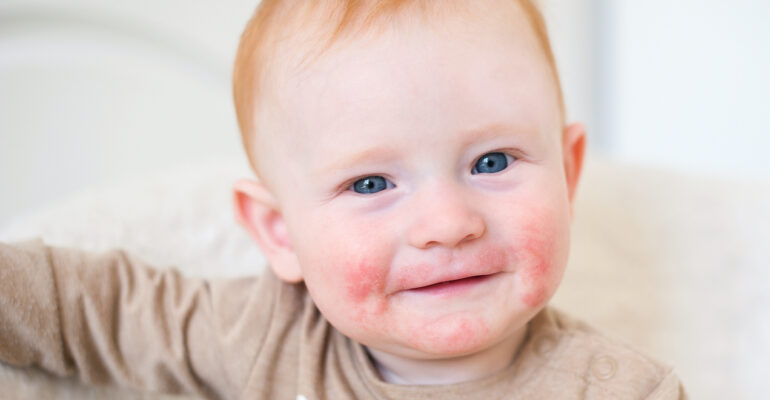Atopic dermatitis treatment I Dermatologist guide
May 3, 2022 2024-03-04 6:21Atopic dermatitis treatment I Dermatologist guide
As an Amazon associate, Dermatocare earns from valid purchase made by clicking on the affiliate links in this blog.

Atopic dermatitis treatment I Dermatologist guide
“Doctor, my daughter has atopic dermatitis. She gets rash as soon as I stop using steroid creams and anti-allergic. Is there any atopic dermatitis treatment that works?”
This is the first request I get from parents struggling to stop flares of atopic dermatitis. After successfully treating hundreds of patients with Atopic dermatitis at our clinic, I am sharing the atopic dermatitis treatment that will prevent a new episode. You should consult a dermatologist immediately when your child has a severe rash. Meanwhile, follow all the tips given in this article.
What causes Atopic dermatitis?
Atopic dermatitis is caused by an inherent deficiency of Nature moisturizing factors (NMF) and increased skin reactivity. Atopic dermatitis can be triggered by food, cloth, sweat, winters, dryness, stress..the list is long. Watch this video for the complete list.
The treatment of atopic dermatitis focuses on avoiding triggers. Children who could not be controlled with oral steroids are now better with stringent skincare and avoiding triggers mentioned below.
Symptoms of Atopic dermatitis
Atopic Dermatitis can present with the following symptoms:
- Dryness and roughness of skin
- Itching is usually severe and occurs in episodes triggered by heat, low humidity, woollen and synthetic clothes, and sudden change in temperature.
- Rashes on body fold like eyelids, neck, at the bend of arms, wrist, and back of the knees. In severe cases, the whole body may be involved. The rash can be red and oozy initially, but with time skin becomes brown and thick, if proper treatment is not given.
The good news is that most children show remission during adolescence, but they might have eczema on hands, eyes, ears, etc. during adulthood.
Thus, professions that involve contact with chemicals like hairdressers, artisans, cookery, chemical industries, etc. should be avoided.
Watch this video to learn about symptoms in detail, especially to understand the reason why your child cannot stop itching voluntarily.
Atopic dermatitis treatment
Most parents think atopic dermatitis treatment involves the application of steroids, but in real treatment lies in keeping the skin hydrated, avoiding triggers, reducing the child’s stress, and starting over-the-counter anti-allergic syrups and steroids as soon as your child gets a rash.
Given below is the atopic dermatitis treatment protocol to be followed based on the condition of the skin of the child:
Dry skin, No rash
This is the most common scenario once your child’s fare gets better. Most atopic kids keep on having dry skin and itching off and on because their skin is still prone to dryness and reactivity.
The skin barrier of atopic skin is breached easily. The warning sign for the onset of atopic flare is dry and flaky skin with occasional itching. At this point, you must keep your child’s skin hydrated, and the chances of flares will reduce drastically.
After treating thousands of kids with atopic dermatitis, I can guarantee you that the skincare regime below can prevent flares in mild to moderate cases of atopic dermatitis in 70 % of cases.
Step 1: Bath
The right bathing technique is paramount because elaborate baths with hot water can strip NMF (natural moisturizing factor) from the skin. Here are a few points t consider:
Use lukewarm water.
Give short baths. Half bucket or a quick shower is ideal.
Use a non-soap fragrance-free body wash.
Avoid regular soap bars because they can disturb the skin barrier. The right cleanser can preserve the natural lipid layer of the skin. It doest not disturb the pH of the skin.
Brand recommendations: Cetaphil RestoraDerm® Eczema Calming Body Wash
Step 2: Put coconut oil liberally
After the bath, pat dry with a soft towel and put a liberal amount of coconut oil on the slightly damp skin of the full body. Use a hypo-allergenic moisturizer if your child’s skin gets red, irritated, or itchy with coconut oil.
Step 3: Apply moisturiser as soon skin gets or itchy
This is by far the most important step. Apply moisturizer on the rash as soon as your child’s skin gets dry or itchy. The recommended frequency is:
- Every 2 hours till the skin is itchy and dry
- Shift to 4 hours once the skin gets hydrated
- Put 6-8 hourly even if your child’s skin is not dry.
A good moisturizer with ceramides soothes the inflammation and reduces the itching sensation in areas prone to dryness. In contrast, the wrong moisturizer can be a disaster for atopic skin. If your child’s skin still feels dry, then your should try wet wrap therapy.
Apply moisturizer to the full body of the child before sleeping. You should moisturise your child’s skin twice a day, even if it is normal. In the morning, use coconut oil and at night, use eczema moisturizer.
Brand recommendations:
Step 4: Avoid triggers
Besides skincare, you have keep your eyes open to triggers given below. Often, we can trace flare to one of the triggers mentioned below:
Skin care products
Any skincare product can trigger atopic dermatitis. Once the skin is sensitive, then products that suited earlier might become a trigger. Therefore, stick to the products prescribed by your dermatologist. Do not try cosmetics, fragrances, herbs, home remedies, or normal moisturisers. They might trigger rash.
Cloths: The only fabric that suits atopic skin is cotton. Avoid synthetic or wooden. If your child says that a particular attire is itchy or uncomfortable, then believe him/her. Avoid artificial jewellery or any nickel-based buckles or bands.
Beddings: Avoid fluffy, furry and woollen stuff. Cover them with cotton.
Toys: Avoid stuff toys, slime, chemical based toys, cosmetics, nickel etc.
Pets: While it is not easy, avoid direct contact with pet if you see a definite relation.
Food: Food can trigger Atopic dermatitis in children. Avoid following if you see a correlation until nine months of age.:
- cow’s milk
- peanuts
- seafood
- wheat
- soya
- uncommon food items
Only introduce one food item in a week. Even for older children, introduce a new flavor of ice cream or a new brand of biscuits once per week. Maintain a food diary. Write down the flare date and see if you have introduced anything new in the last few days. If you notice the repetition of food items in your dairy. Avoid them.
Carpets: Carpets catch dust, so does heavy curtains, furniture, statues, etc. Keep your home less stuffed.
Play in the park or on floor: The hygiene hypothesis plays an important role in Atopic dermatitis. The cleanser child is kept more is the chance of allergy. Let your child crawl on the floor or play in the park and get dirty in rainwater when they are not flaring up. However, avoid the above triggers, have a skin rash, or find a correlation with flare.
Molds (silan in hindi): Molds tend to inhabit rooms that are less airy and damp. So, ensure that you let enough light and sun shine into your home.
Improve gut microbiome: Many studies prove that probiotics can improve atopic dermatitis. Good bacteria in the intestine prevent leaky gut. Therefore, curd or Yakut is good for atopic kids. Avoiding junk and unhealthy food can also help.
Mild rash with constant itching
While dryness is a constant feature of atopic dermatitis, rash and itching indicate the onset of inflammation and flares. The rash can appear in the form of grittiness, redness, scaling, oozing, thick skin, or red spots. Itching is usually severe and your child can’t help but scratch the skin. The more your child scratches, moe rash would flare.
Therefore, it is important to start OTC allergy syrups and steroids right away. if the rash is mild and present at few areas, then the atopic dermatitis treatment given below is enough. Do not discontinue the skincare regime given above because steroids can ease inflammation and the right moisturizer will aid in healing your skin
Apply steroid cream on area of rash
Apply Steroid cream prescribed by the dermatologist on the rash twice daily or as directed by your doctor.
Stick to the time duration instructed by your dermatologist. Generally, it is safe to use mild steroids like fluticasone on the body or desonide or hydrocortisone on the face for two weeks. The overuse of steroid cream has side effects like skin thinning, infection, stretch marks, etc., as explained in this article.
Steroids work like magic. However, if you stop them abruptly, eczema comes back. The idea is to reduce them gradually. We usually recommend twice a week application of steroids for a month to avoid recurrences. If relapse occurs, your doctor will replace them with non-steroidal preparation like tacrolimus or pimecrolimus.
Brand recommendations: Aveeno Maximum Strength 1% Hydrocortisone Anti-Itch Cream is available OTC in The United States. Use it twice a day for 14 days. However, it is the mildest steroid that might not be enough. In case you don’t see the response, book a consult with your GP or dermatologist.
Give anti-histaminic syrups
Atopic dermatitis is an “itch that rashes”. Meaning that Itching triggers the rash. Moreover, itching is compulsive. Itch is not at all under the control of your child. Therefore, no point in scolding them when your child itches badly.
The first step is to make them feel at ease. Any strong emotion from your side can trigger the itch in your child. If you see your child itching, hug them and gently take their hands off the rash. Apply moisturizer and give anti-allergic syrup.
Most parents avoid giving anti-allergics to eat. But that is going to make the condition of your child worse. Give them an anti-allergic prescribed by your dermatologist twice a day in the beginning and then at night until the rash settles. Night-time anti-allergic will give good sleep. The child won’t scratch unknowingly at night.
Brand recommendations: Allegra (above six years) can be given during the day time and Cetirizine (above two years) at night. Do ask for the dose from your doctor.
Severe rash with multiple area involvement
Sometimes atopic dermatitis is quite severe and presents with multiple rashes and severe itching. In such cases, a delay in starting the therapy is detrimental. You should immediately rush to a skin doctor for treatment. Many times parents delay consults. The doctor can’t avoid oral steroids and antibiotics in severe cases.
Your dermatologist might prescribe:
- Most of the mild cases settle with the application of topical steroids only.
- Anti-bacterial and anti-viral, if there are signs of infection.
- Anti-histaminic syrup to reduce itching and help to put your irritated child to sleep.
- Oral steroids can be used.
- Recurrent cases may be put on tacrolimus and pimecrolimus.
- In rare cases, immunomodulators like cyclosporine may be needed.
Can Atopic dermatitis run in the family?
Yes! Atopic dermatitis runs in the family. If one parent is affected, there is 50% chance that the child might develop AD, but this percentage increases to 80% if both parents are affected.
To conclude, atopic dermatitis treatment focuses both on prevention and cure. A step up regime is advocated based on the severity of rash.
ROUTINE FINDER
Get free dermatologist-recommended regime by choosing your skin or concerns.

FACE

HAIRS

CHILD

BODY
